Abstract
The living conditions in the Urmia Basin (northwestern Iran) face significant challenges due to dust events. This study investigates the spatial and temporal characteristics of dust phenomena in the Urmia Basin using MERRA-2 data and observational data from Tabriz, Urmia, Sarab, and Mahabad over a 30-year period (1990–2019). The findings reveal that despite several fluctuations, the annual number of dusty days increased from the 1990s to the 2010s in the Urmia Basin. The maximum number of dusty days was found to predominantly occur in May (spring) and October (autumn), driven by two distinct mechanisms. In early autumn, developing synoptic systems associated with increased wind speeds can cause dust emission from dry land sources. Consequently, an increase in dust wet deposition, precipitation, dust surface concentration, and the number of dusty days occurs in October. In contrast, a sharp decrease in precipitation from April to May leads to drying soil and dust emission in May. Among the studied cities, Tabriz experienced the highest number of dusty days (728) due to the combined effects of cross-border and local dust sources. The highest dust column density and dust dry deposition in the south and east of Urmia Lake indicate the impact of declining water levels, which resulted in a dry lakebed as the primary local dust source. The MERRA-2 spatial distribution reveals that dust surface concentration, and the number of dusty days decrease similarly from the southwest to the northeast of the Urmia Basin as the distance from cross-border dust sources increases. A positive correlation is observed between the number of dusty days and MEERA-2 data, including dust surface concentration, dust dry deposition, column mass dust, and total aerosol extinction, with coefficients of 0.74, 0.71, 0.69, and 0.68, respectively.
1. Introduction
Dust storms originate from arid and semi-arid regions, encompassing vast deserts with a high potential for dust emissions across the globe, particularly in southwest (SW) Asia [1,2,3,4]. Mineral dust has a broad range of consequences, as highlighted in the literature, including effects on the radiation budget, climate, air pollution, human health, and the environment [5,6,7,8].
The dust life cycle consists of various processes, including surface emission, lifting into the atmosphere, transportation to other regions, and deposition [9,10]. Several factors contribute to each stage of the dust process. Synoptic systems play a role in dust emission from deserts and dry lands, with increasing near-surface wind speed being the most critical factor in dust emission at the source. The wind direction and speed in the mid-atmosphere transport dust mass far from its source to neighboring countries [10,11,12,13,14,15,16,17].
A substantial portion of dry deposition in the world’s desert regions is attributable to dust. Dust deposition occurs downwind in areas far from the dust source. Dust deposition is a critical process in downwind receptor areas as it determines the amount of dust mass settling on the surface. There are two types of deposition: dry and wet; when dust particles fall to the surface from the atmosphere, dust dry deposition occurs, while wet deposition involves transporting precipitation associated with dust from the atmosphere to the Earth’s surface. Recent research indicates that dust deposition during a single dust storm event can be 10 to 25 times greater than its annual average [18,19]. A study in the eastern Mediterranean demonstrated that the dry deposition in two dust events observed in May 1992 accounted for about 30% of the total annual dry deposition [20]. In the western Mediterranean, wet deposition is the most critical factor in dust deposition [21].
The dust cycle affects areas at the source, along pathways, and in receptor regions. Dust events affecting Iran originate from local sources and beyond its borders [22]. Northwest (NW) Iran has experienced dust storms [23]. The first recorded dust event in the region was reported between 1984 and 1988 [24]. The primary dust sources affecting air quality in northwest Iran are located in Syria and Iraq [25,26].
Dust has influenced agriculture, the economy, and human life, including health and migration, in northwest Iran from 2019 to 2020 [27].
The analysis of aerosols in Lake Urmia from 2006 to 2017 using MODIS and CALIPSO data revealed that the drying of the lake contributed to the increase in aerosols [26]. An increasing dust trend was obtained in Tabriz, a city near Lake Urmia in northwest Iran, from 2007 to 2010 [24]. Air pollution levels rose during the ten years leading up to 2019 [28].
Due to the water’s salinity, local salt dust can negatively affect human, plant, and animal conditions [29]. Projections of the drying effect on Lake Urmia suggest that PM10 emissions in the region may increase by 30 to 60% [30].
Although numerous studies have examined Lake Urmia from various perspectives, such as climate change and water level variation [31,32,33,34], the spatial dust variation in the Urmia Basin has not been thoroughly investigated.
The temporal variation of dust has been analyzed using observational data from synoptic stations; however, illustrating spatial variation remains challenging. Satellite data and remote sensing database models, such as MERRA-2, offer coarse spatial resolution and global coverage, making them suitable for examining the spatial distribution of variables and long-term time series.
Modern-Era Retrospective analysis for Research and Applications, version 2, also known as MERRA-2, has been widely used in dust research worldwide [35,36,37,38,39,40,41,42] and in Iran [43,44,45,46] in recent years.
Research conducted using MERRA-2 data in Iran shows that the highest dust concentration occurred in the south and southwest during the last decade (from 2010 to 2020) [43]. Additionally, the MERRA-2 dust column density trend increased in southwest Africa from 1990 to 2020 [41]. The source and daily variation of MERRA-2 dust column mass concentration was considered over East Asia [39]. The spatial distribution and temporal variation of aerosols was identified using MERRA-2 data in India [42].
Due to the unknown long-term spatial distribution of dust in the Urmia Basin, this study aims to examine dust spatial variation using several dust variables, including dust surface mass concentration, column mass dust density, and dust dry and wet deposition from MERRA-2 data, for a 30-year period (1990–2019).
Furthermore, MERRA-2 data also depict the value of dust concentration in the region where direct measurements are not conducted.
The temporal variation of dust, including intra-annual, annual, and seasonal dust, will be investigated and analyzed using MERRA-2 and observational data throughout the basin from 1990 to 2019.
2. Study Area
The Urmia basin is limited to 35.67° to 38.50° N and 44.12° to 47.88° E, with 51,876 to 52,000 area. It is located in the northwest of Iran and connected to the Turkish border in the northwest and Iraq in the southwest border (Figure 1). Urmia Lake was the highest and largest Lake in Iran, located in the Urmia Basin [47,48]. The length of the lake was approximately 120 to 150 km from north to south, and its width ranges between 20 and 50 km [48,49]. The Urmia Basin features diverse topography and water sources, including 21 permanent and seasonal rivers. The Zarinehroud River is the most water-rich among them [50,51].
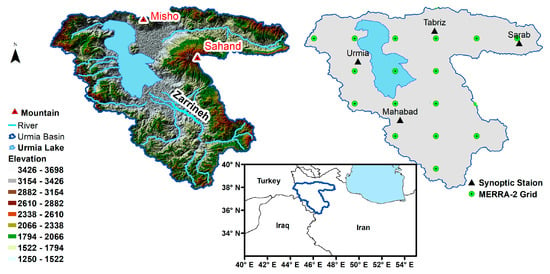
Figure 1.
Location of Iran and its western neighbors, the Urmia Basin and Lake Urmia. On the left side, topography (m), rivers (blue lines), and main mountains are shown; on the right side, meteorology stations (filled triangles) and MERRA-2 grid points (green circles) are displayed.
The water level of Lake Urmia has decreased, particularly in the significant areas of the south, southeast, and northeast, which exhibit the broadest range of snow drought severity in these parts [52]. The southern shores of Lake Urmia have the shallowest depth, and they are located at the mouth of the permanent and full-flowing Zarineroud River. The construction of a dam and water extraction from this river have reduced the amount of water entering the lake, as mentioned in previous research [53]. Additionally, the retreat of the waterline has led to the expansion of salt marshes and an increase in barren lands [53].
The Urmia Basin has encountered significant challenges in recent years, including a negative balance of aquifers, land use changes, increased surface erosion rates, heightened sediment loads in rivers leading to the lake, expansion of irrigated agricultural lands, and a shift from low-water consumption crops to those with higher water demands. These factors have contributed to a decline in water levels and an acceleration of the drying process in Lake Urmia [54,55]. The water level of Lake Urmia is compared using the visible image of the Terra satellite on 6 July 2002, 6 July 2012, and 6 July 2022 in Figure 2.
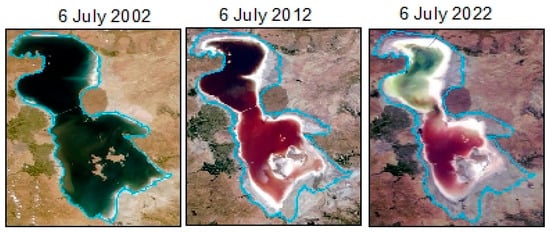
Figure 2.
Urmia Lake on 6 July 2002, 6 July 2012, and 6 July 2022. MODIS visible image.
Since Lake Urmia plays a vital role in the climate of NW Iran [56], a continuation of the drying process may lead to serious environmental challenges in the region [28,30,48,49,57].
The southern and eastern parts of Lake Urmia have been dried in recent years [58]. There is some evidence that the dryness of Lake Urmia in recent years is the main cause of an increase in the concentration of aerosols in the Urmia Basin [26]. There are alluvial plains and floodplains in northeastern Urmia Lake. The dried lakebed and alluvial plains of the northeastern basin may serve as the primary local dust sources in the Urmia Basin [59].
The drying of Lake Urmia contributes to the increasing local dust and aerosol (NaCL) emissions and leads to increase air pollution [33,60], which negatively influences air quality, particularly during summer [26].
The inverse relationship between Lake Urmia’s water level and air pollution has been demonstrated in northwestern Iran and eastern Turkey [28].
The one important point is as follows: Lake Urmia, situated in northwest Iran, can serve as an internal dust source due to its drying condition.
3. Data and Method
3.1. Meteorology Data
The observation data are obtained from the Iran Meteorological Organization for 1990 to 2019 period. This data are available in three-hour intervals, resulting in eight weather reports per day. There are numerous stations in the Urmia basin, with some being newly established and others requiring more data. Tabriz, Urmia, Mahabad, and Sarab were selected as sample stations with long-term databases without missing 3-h data, as shown in Figure 1 and Table 1. Tabriz station is located 70 km east of the lake, while Urmia is 18 km west of the lake [28].

Table 1.
Location of selected stations in the Urmia Basin (1990–2019).
During dust occurrences, horizontal visibility tends to decrease. Based on the protocol stipulated by the World Meteorological Organization (WMO), dust phenomena are categorized into four distinct classes based on visibility parameters (see [61] for more details). Suspended dust, blowing dust, dust storm, and severe dust storm are the various categories based on a visibility of less than 10,000 m.
A dusty day is defined when horizontal visibility is less than 10 km and one of the following codes in the present weather: 6, 7, 30–35, and 98 (reported same as in [62]). Table 2 provides a description of these codes.

Table 2.
SYNOP present weather (WW) codes relevant to atmospheric dust considering the identification of dust events in Tabriz, Urmia, Mahabad, and Sarab.
The dusty day number is calculated based on these criteria if dust has been reported at least once daily with a horizontal visibility of less than 10,000 m [62]. To investigate the temporal dust variation, the total number of dusty days in each station was applied in annual and seasonal variations, as well as the relative frequency of dust hourly reports and the horizontal visibility in annual variations from 1990 to 2019.
The wind plays an essential role in the emission, spreading, and transporting of dust in the atmosphere. An increase in near-surface wind speed over dry land and deserts leads to dust emission.
One of the mechanisms that can lead to strong surface winds is the breaking of the low-level jet (LLJ) [63,64]. The dust emission took place due to LLJ caused by synoptic conditions [65,66]. The atmospheric processes forcing synoptic, regional, local, and turbulent scales can generate LLJ, which it is a reason for exceeding wind speeds rather than those of the local threshold [67] and force dust mobilization.
Hence, the increased wind speed in the mid-atmosphere (synoptic systems) and geographical structure are two factors necessary to enhance near-surface wind speed. To better understand the prevailing wind conditions, a wind rose is plotted based on the direction and speed of the 10-m wind data when dust is reported.
3.2. MEERA-2 Data
The MERRA-2 (Modern-Era Retrospective Analysis for Research and Applications, version 2) is a model developed by NASA’s Global Modeling and Assimilation Office (GMAO). It operates using satellite data from various sources, including the Advanced Very-High-Resolution Radiometer (AVHRR), Moderate Resolution Imaging Spectroradiometer (MODIS), Multiangle Imaging Spectroradiometer (MISR), and Aerosol Robotic Network (AERONET) Lidar [68]. MERRA-2 products have a spatial resolution of 0.625° × 0.5° (576 points of longitude and 361 points of latitude) and are available from 1980 to the present.
In this study, some variables, including dust surface mass concentration (abbreviated dust surface concentration), air dust column mass density (abbreviated dust column density), dust dry deposition for all particles, dust wet deposition, total aerosol extinction AOT 550 nm (abbreviated AOTA), and dust extinction AOT 550 nm (abbreviated AOTD), were prepared from MERRA-2 according to a monthly temporal resolution from 1990 to 2019.
The dust surface mass concentration demonstrates the near-surface dust value, and the dust column density represents the dust aerosol loading within the entire atmospheric column [39].
The aerosol optical depth (AOD) is the vertically integrated extinction coefficient, and the aerosol optical thickness (AOT) is defined as the total extinction coefficient in the vertical column of the atmosphere. Both of them are the same and present an atmosphere turbidity. An increase in aerosols leads to greater attenuation of solar radiation and increased atmospheric turbidity. An AOD or AOT value between 0.05 and 0.2 indicates a clear sky, whereas polluted air is represented by values increasing to 1. A value greater than 2 also signifies an increase in pollutant concentration [32].
As the dust particle is one of the different aerosol kinds. In this study, two AOT are used to compare the total atmospheric aerosol and dust attenuation because of the dried salty Urmia Lake, which can be source of different aerosol types plus dust particles. The total aerosol extinction AOT 550 nm presents atmosphere turbidity due to dust, sea salt, sulfate, and organic carbons particle, while the dust extinction AOT 550 nm is due to dust.
The 550 nm wavelength falls within the visible spectrum of sunlight, thus making it a practical choice for measurements, as it is within the range of human visibility and passes through the atmosphere with relatively low absorption and scattering. The 550 nm is sensitive to the presence of aerosols in the atmosphere. Aerosols, which include particles such as dust, smoke, and pollution, are efficient scatters of light in the visible spectrum.
Wind and precipitation are other variables related to dust occurrence, which is used in this research. Total surface precipitation is an effective factor in dust wet deposition, while wind speed and direction are the primary factors in emitting, spreading, and transporting dust. So, total surface precipitation and wind data at 850 and 700 hPa have been extracted from MEERA-2 data. The variables used in this research are listed in Table 3.

Table 3.
Selected MERRA-2 in monthly and observation data in 3-h temporal resolution, 1990–2019.
3.3. Method
In this study, we analyzed the sum of dusty days and the visibility monthly mean using observational data collected between 1990 and 2019 in the Urmia Basin. The spatial distribution of MERRA-2 variables was plotted for the same period using GrADS software, with black triangles representing the positions of synoptic stations in the spatial distribution figures. A comparative analysis of the spatial distribution of dusty days and MERRA-2 dust variables was performed. Furthermore, we examined the annual, seasonal, and hourly variations of dusty days to better understand the temporal patterns. Lastly, the MERRA-2 variables were extracted for the Urmia Basin in a time series format to investigate the relationship between MERRA-2 dust data and the number of dusty days. The average of the data obtained in the Urmia Basin was multiplied by its area. For this reason, their units differ from the values presented in Table 2. Finally, to examine the MERRA-2 data representing dust storms in the Urmia Basin, a widespread and severe dust storm that occurred from 28 to 31 October 2017 in the northwest of Iran was selected and studied. A complete description is provided in the article by Mobarak Hassan and colleagues (2023) [69]. In the current research, MERRA-2 and MODIS data are presented, and the backward trajectory of particles was plotted using the HYSPLIT model.
The HYSPLIT model is a dual model that can calculate dust trajectories and dispersion and simulate its deposition using puff and particle approaches [70]. This study uses the online HYSPLIT model to determine the backward trajectory.
A time of 1800 UTC in the 29th and 30th of October were selected as the final times of the particle path in Tabriz, Urmia, Sarab, and Mahabad. The model was run with 1° × 1° meteorological field data from the NCEP Global Data Assimilation System (GDAS) to calculate the 12 h backward one trajectory with a time interval of 3 h of airflow at a height of 1500 m because of basin elevation. To authenticate the sources of dust, ArcGIS was employed to superimpose the trajectory. It ascertained from the HYSPLIT model on the MODIS visible imagery. True color images, harnessed from the MODIS sensor aboard the Aqua satellite, were utilized for this purpose.
4. Results
4.1. Spatial Distribution of Dust
In the first step of our analysis, we examined the observational data. The total number of dusty days from 1990 to 2019 is illustrated for each synoptic station in Figure 3. Mahabad and Urmia experienced the fewest dusty days, with 254 and 295 days, respectively. This can be attributed to their location in the western part of the basin and proximity to cross-border dust sources (Figure 3). Conversely, the Sarab station, situated in the easternmost part of the basin, recorded the lowest frequency of dusty days, with 200 occurrences. This could be due to its greater distance from the cross-border dust sources, as well as other factors including its geographical location, high elevation of 1682 m (Figure 1), and weak wind speeds (Figure 3).
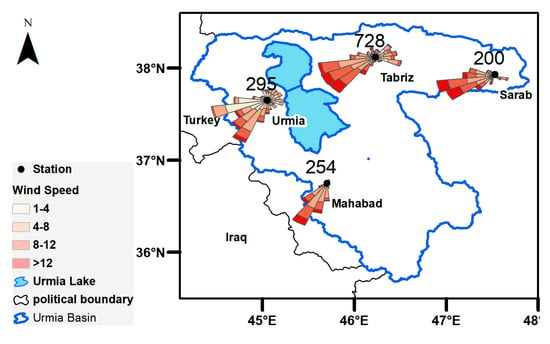
Figure 3.
The total of dusty days and wind rose dust events in Urmia, Mahabad, Sarab, and Tabriz station, during 1990–2019.
While it was initially anticipated that the number of dusty days would decrease from west to east due to increasing distance from dust sources, Tabriz recorded the highest number of dusty days at 728. The dust conditions in Tabriz are notably different from those at other stations, with the number of dusty days being 2.5 times greater than that of Urmia, which is situated at the same latitude. Given that Tabriz is located in the eastern Lake region and far from cross-border dust sources, the drying of the lakebed could be a factor contributing to the emission of local dust and an increase in dusty days. This phenomenon will be discussed in detail later in the study.
A wind rose serves as an indicator of the dominant wind direction. The prevailing wind direction at all four synoptic stations was southwest (Figure 3). This observation confirms the influence of synoptic systems associated with dust mass and their pathways on the Urmia Basin. The decreasing number of dusty days from the southwest to the northeast, along with the prevailing southwest wind direction, are consistent with the patterns depicted in Figure 3.
Tabriz, situated in the highlands, extends with a gentle slope towards the north and northeast of the lake, which consists of alluvial plains and floodplains [59]. Additionally, desertification and the increase in various aerosols due to the water level decline in the northeast of Lake Urmia by up to 500 m [58] could serve as sources for salty soil particles. Consequently, the prevailing southwesterly winds can transport dust and salt particles from Lake Urmia to Tabriz (Figure 3). Winds blowing over the dry lakebed contribute to the dispersion of dust.
In addition to the wind direction varying between 180 and 270 degrees during dust events at Tabriz and Urmia stations, there were also easterly winds. The synoptic cooperation system and geographic conditions are factors that contribute to the change in wind direction to easterly, which, in turn, transports dust from Lake Urmia and increases dust events in the city of Urmia or other cross-border dust source for Tabriz city. The easterly winds develop when the low pressure over Iraq and high pressure over the Caucasus dominate [28]. It is worth noting that, based on the results of the study, easterly winds form under these specific conditions.
The wind speed range is another characteristic of wind rose. The highest wind speed frequency at 4 to 8 has been 38.5%, 33.8%, and 29.1% in Mahabad, Tabriz, and Sarab, respectively. Urmia has the highest relative frequency (36.2%) at wind speeds 1 to 4 . Hence, the prevailing wind speed in Urmia is lower than the other stations, notwithstanding the Urmia Basin being affected by synoptic systems.
The frequency of wind speeds over 12 was 7.7% in Tabriz, 7.4% in Mahabad, 4.8% in Urmia, and 3.7% in Sarab. The highest 10 m wind speeds over 12 occur in Tabriz and Mahabad. Nevertheless, the difference in the number of dusty days suggests that other factors influence dust events in Tabriz. Since an increase in wind speed near the surface is a crucial factor in dust emission, higher wind speeds raise the likelihood of local dust emission around Tabriz, particularly in the eastern areas near the northeast of Lake Urmia.
Urmia, located close to the border of Iraq—a primary dust source—has fewer dusty days than Tabriz. The presence of high mountains along the western border serves as a barrier against the entry of dust from cross-border sources associated with southwesterly winds. When dust is lifted into the middle layers of the atmosphere, it can pass over the mountains and affect the central and eastern regions of the basin. Additionally, the passage of dust from Iraq to the eastern borders of Turkey can be due to the prevailing westerly and southwesterly wind direction. As synoptic systems pass over the mountainous regions of eastern Turkey, they can effectively reduce the intensity of dust or the number of dust events in the city of Urmia.
The variables averaged from 1990 to 2019 have been plotted in the Urmia Basin (Figure 4). The dust surface concentration decreases from the southwest to the northeast of the basin (Figure 4). Because of the proximity of the southwest Urmia Basin to the cross-border dust source in Iraq, the highest dust surface concentration value of 47.5 has been seen in Mahabad (Figure 4a). The lowest dust surface concentration of 25.33 has been demonstrated in the northeastern basin near Sarab.
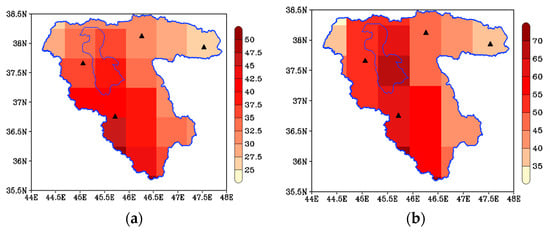
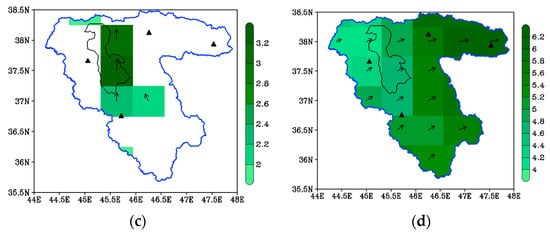
Figure 4.
(a) Dust surface mass concentration (); (b) dust column mass density (); (c) wind speed () and direction (arrows) at 850 hPa level; (d) wind speed () and direction (arrows) at 700 hPa level in the Urmia Basin, 1990–2019. Filled triangle shows selected synoptic station, the Urmia Basin border shows in line blue.
The dust surface concentration in the southern and northeastern regions of Urmia Lake (Figure 4a) is higher than that of the surrounding areas, which can be observed in parts of the lake’s drying bed (Figure 2).
The pattern of dust column density, however, differs from the dust surface concentration (Figure 4b). The dust column mass density represents the dust aerosol loading within the entire atmospheric column (Liu et al., 2022), indicating the potential for dust mass to be transported over long distances. The height and direction of the mountains, as well as the southerly wind at 850 hPa (Figure 4c), contribute to the extension of dust column density from the southern to the northern basin (Figure 4b).
The dust column density obtained in Mahabad is 63.45, Urmia is 3.21, Tabriz is 46.05, and Sarab is 35.29 .
Mahabad and Urmia exhibit higher dust column densities due to their proximity to cross-border dust sources, while Sarab experiences lower dust column densities because of its far distance from these sources.
The highest value of 70 of dust column density is in the south of the Lake (Figure 4b). It could be due to the Lake drying up and releasing dust to the atmosphere’s mid-level.
The southerly wind blowing over Lake Urmia at 850 hPa (Figure 4c) is a key factor in transferring dust over the lake from the south to the north within the central part of the basin. Given that mountains surround the lake to the east and west, wind field channelization occurs in this area.
The predominant southwest wind direction at the 700 hPa level (Figure 4d), which is associated with the synoptic system, aligns with the prevailing wind rose direction observed at meteorological stations (Figure 3). This pattern demonstrates the transportation of dust mass from Iraq to the Urmia Basin.
The horizontal distribution of dust dry deposition (Figure 5a) and dust surface concentration (Figure 4) are similar throughout the basin, decreasing from southwest to northeast, except in the north–south direction of Lake Urmia, which is consistent with dust column density.

Figure 5.
(a) Dust dry deposition (); (b) dust wet deposition (); and (c) total surface precipitation () in the Urmia Basin, 1990–2019. Filled triangle shows selected synoptic station, the Urmia Basin border shows in line blue.
The decreasing dust surface concentration and dust dry deposition from southwest to northeast in the basin align with the number of dusty days (Figure 3, Figure 4 and Figure 5). The highest dust dry deposition value of 28 was found in the southwest part of the basin (Figure 5).
Dust dry deposition values in the southern parts of the lake are higher than in the surrounding areas. The distribution of dust dry deposition is influenced by the lower elevation of the lake and the high mountain barriers surrounding it. Additionally, the slope of the mountain plays a crucial role in directing and accumulating dust over the lake. Dadashi-Roudbari et al. (2020) [44] reported a negative correlation between dust dry deposition using MERRA-2 data and mountain height in Iran. The results demonstrate that dust dry deposition in the mountainous regions of the Zagros and Alborz ranges decreases with increasing altitude.
Tabriz has the highest number of dusty days (Figure 3), while dust surface concentration, dust column density, and dust dry deposition values do not show higher values in Tabriz or its surroundings. In contrast, the number of dusty days in Urmia is slightly greater than in Mahabad (Figure 3), even though the dust surface concentration and dust column density values are higher in Mahabad.
The number of dusty days indicates the frequency of dust events, which may sometimes occur for just one hour a day, while dust surface concentration and dust column density values represent dust intensity. Therefore, perfect agreement between observational and MERRA-2 data cannot be expected. The spatial resolution of MERRA-2 data, with grid point pixels of 0.625° × 0.5°, is another factor that may not accurately capture small-scale phenomena. Consequently, the effects of local conditions may not be apparent in the MERRA-2 data for dust in Tabriz and Urmia.
Dust wet deposition values are 130, 112, 81, and 80 in Mahabad, Urmia, Sarab, and Tabriz, respectively (Figure 5). The spatial distribution of dust wet deposition differs from other dust variables due to the direct effect of precipitation (Figure 4 and Figure 5). The highest values of dust washout are found in the south (600 ) and southwest (700 ) of the Urmia Basin. The increased dust wet deposition (600 ) is illustrated in the land beside southeast Lake Urmia, near Sahand Mountain, which influences rainfall (Figure 5c) and supplies water to the two main rivers: Zarineh Rood and Simineh Rood.
The amounts of surface precipitation in Urmia, Sarab, Mahabad, and Tabriz are 19.39, 17.21, 16.68, and 14.80 , respectively. The highest precipitation occurs in Urmia and then Sarab due to the simultaneous influence of precipitation and mirage weather systems.
There is a similarity between the spatial distribution of precipitation and dust wet deposition, overriding the mountainous structure. However, differences between the two parameters exist in the eastern parts of the Lake near Sarab, due to the lowest number of dusty days and high elevation. The lowest dust wet deposition and dust day numbers correspond in Sarab. The presence of more precipitation and less dust wet deposition suggests that the rainy season and dusty season are distinct from each other.
The AOTA value is 0.13, 0.12, 0.11, and 0.09 in Mahabad, Urmia, Tabriz, and Sarab, respectively (Figure 6a). The highest AOTA of 0.14 appears in the southern parts of the basin and northeast of Lake Urmia, owing to NaCl and other aerosols from the lake’s drying bed and the entry of salty soil into the atmosphere [26]. This highlights the effect of drying portions of Lake Urmia on decreasing air quality. In addition, the high AOTA in the southwest of the basin (Mahabad) is associated with synoptic systems and aligns with other dust variables. In addition, the cross-border dust mass contains different types of aerosols (sea salt, sulfate, and organic carbons) from neighboring countries, and their deposition affects water sources. If the dust mass contains iron and aluminum, it increases the primary production of phytoplankton and stimulates growth [44,71,72,73]. The positive correlation between dust and chlorophyll in Lake Urmia indicates the effect of dust-containing effective particles on increased chlorophyll in the lake [45].
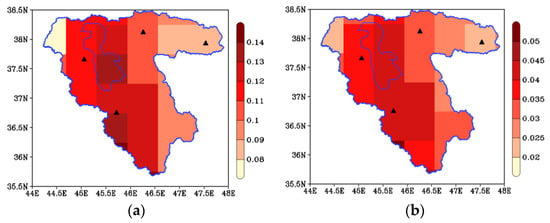
Figure 6.
(a) Total aerosol extinction AOT (AOTA); (b) dust extinction AOT (AOTD) in the Urmia Basin, 1990–2019. Filled triangle shows selected synoptic station, the Urmia Basin border shows in line blue.
The lowest AOT value was 0.09 in MERRA-2 data in the Urmia Basin, which is less than the AOT threshold for air pollutants or dust. It should be noted that the AOT value obtained is for a long-term average and does not show an increase in pollutant events.
The AOT value obtained from MERRA-2 is lower than the AOD presented in other satellite data, namely, MODIS [74]. The AOT of aerosol and dust spatial variation present a different structure in some areas (Figure 6b). In addition, the dust AOT value is less than the aerosol AOT.
4.2. Temporal Distribution of Dust-Related Meteorological Conditions
The total number of dusty days shows an increase over three decades, from 1990 to 2019, in the selected synoptic stations (Table 4). The number of dusty days in each decade in Tabriz is more significant than in the other three stations, indicating long-term dust in Tabriz. Although the climatic conditions of Tabriz are not suitable for dust emission, the frequency of dusty days has increased since 1956, according to [75].

Table 4.
Total number of dusty days in synoptic stations from 1990 to 2019.
A sharp increase occurs from the 2000s to the 2010s in Urmia, Mahabad, and Sarab. The number of dusty days in the 2000s increased to 215 days in the 2010s in Mahabad.
While the number of dusty days increased from the 1990s to the 2010s in the selected synoptic stations, intra-annual variation of dusty days experienced fluctuations (Figure 7a). Hoseine Sadr et al. (2014) [75] identified two decreasing periods, two increasing periods, and two periods with medium frequency in Tabriz dust. A non-steady trend of dust, based on extra-local factors being more influential than local factors, has been presented in Tabriz [75]. The sharp increase began in 2008, followed by several fluctuations. However, the number of dusty days decreased in the last years of the 2010s. Boroughani et al. (2019) [48] reported an increase in the number of dusty days in Tabriz and Urmia from 2008 to 2012.
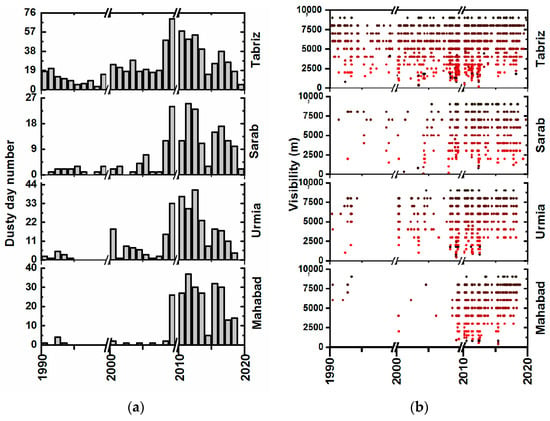
Figure 7.
(a) Inter-annual of dusty days number; (b) visibility () in Mahabad, Urmia, Sarab and Tabriz station, 1990 to 2019.
The lowest horizontal visibility and the highest dust intensity occurred in the Urmia Basin from 2009 to 2012. The decreasing visibility associated with increasing dusty days indicates an increase in dust mass and more frequent dust events in the 2010s.
The lowest number of dusty days occurred in the 1990s and 2000s in Mahabad, which is noticeably different to other stations. After 2009, dust behavior became similar to other cities.
As a result, it can be said that the dust mechanisms leading to formations and transports, soil water content in dust sources, and precipitation were different in the 1990s and 2000s compared to the 2010s. The decreasing visibility associated with increasing dusty days represents the increasing dust mass, and the more frequent dust events occurred in the 2010s, reflecting the development of widespread dust mass in the region. Although the number of dusty days in Sarab was lower than in Tabriz and Urmia, the lowest visibility still occurred. The decreasing visibility in Tabriz was more significant than in other cities—similar to the number of dusty days (Figure 7b)—and it points to the different ways in which dust affects this city.
The increasing number of dusty days and the decreasing horizontal visibility in the 2000s indicate a higher intensity and frequency of dust occurrences in the Urmia Basin, except for Mahabad (Table 5). Visibility has fallen to 100, 300, 400, and 900 in Sarab, Tabriz, Urmia, and Mahabad, respectively, revealing an increase in dust intensity in the 2000s in the Urmia Basin, while the number of dusty days also increased. Despite the lowest number of dusty days, the most intense dust event occurred in Sarab in the 2000s.

Table 5.
Maximum of dusty day number and minimum visibility in 1990–2019.
The number of dusty days continued to increase into the 2010s, while dust intensity increased in Tabriz and Mahabad and decreased in Urmia and Sarab (Table 5). The significant dust increase from 2000 to 2010 in Mahabad indicates the enhancement of dust emissions mainly due to cross-border sources, primarily from Iraq.
The highest number of dusty days in the 2010s shows that the number of cross-border events entering the Urmia Basin has increased, and the dust concentration has also increased in Mahabad and Tabriz based on the decrease in visibility. The dusty synoptic systems (see detail in [69,76]) and local dust sources (Lake Urmia’s drying) collaborated to increase the dusty days and dust intensity in Tabriz in the 2010s.
The monthly distribution of dusty days is illustrated in Figure 8a. The peak of dusty days is detected in May, with 159, 70, 58, and 51 days in Tabriz, Urmia, Mahabad, and Sarab, respectively, from 1990 to 2019. Another maximum was found in October. Thus, the dusty seasons in the Urmia Basin are spring and autumn. A maximum dust event can be expected in the spring because of warmer air and crossing synoptic systems, but the outbreak in autumn is not due to rainy and cold weather. The autumn dusty day numbers are similar in Urmia, Mahabad, and Sarab but different in Tabriz. When autumn arrives, synoptic systems develop and pass over the Urmia Basin. These conditions may activate internal dust sources by blowing wind over the Lake’s drying bed and alluvial plains near the southwest of Tabriz, and local dust is emitted, which has the most significant effect in increasing dust events in Tabriz in September and October. The number of dusty days has fallen sharply in the summer, with the least in August. Thus, dust mostly occurs in May (spring), as mentioned in [27], and October (autumn), contrary to what has been presented by Shahkooeei and Rahmani (2019) [24] as a minor dust occurrence. Significant dust was recorded in June in Mahabad, which is because Mahabad is close to neighboring dust sources in Iraq, as described in previous sections. The minor hourly fluctuations of dust occur with the highest relative frequency of about 14.5% between 0900 and 1500 UTC in Mahabad and Urmia (Figure 8b). However, synoptic dust systems affect all hours of the day.
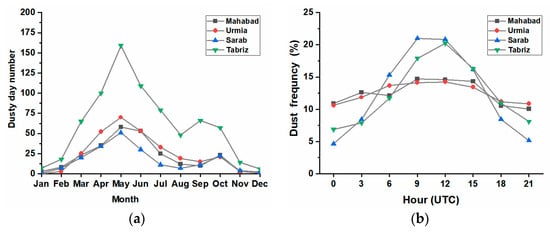
Figure 8.
(a) Seasonal variation of total dusty days and (b) relative frequency of hourly dust report in Mahabad, Urmia, Sarab, and Tabriz, 1990–2019.
The maximum relative frequency of dust (20%) was obtained at 0900 to 1200 UTC in Tabriz and Sarab. The increase in dust frequency in the middle of the day to THE afternoon (12:30 to 15:30 local) indicates different mechanisms of dust emission and transfer in Tabriz and Sarab, probably due to daily warming and instability, inducing local dust sources.
4.3. Temporal Distribution of Dust Characteristics Using the MERRA-2 Data
The temporal distribution of MERRA-2 data shows that the annual variation of dust surface concentration, dust column density, and dust dry deposition have the same fluctuation, except for dust column density from 2008 to 2010 and dust dry deposition from 1994 to 1996 (Figure 9). According to the dusty day number, there were two maximums in 2003 and 2008–2012. MERRA-2 dust data and the dusty day number show similar trends in annual variation (Figure 7 and Figure 9).
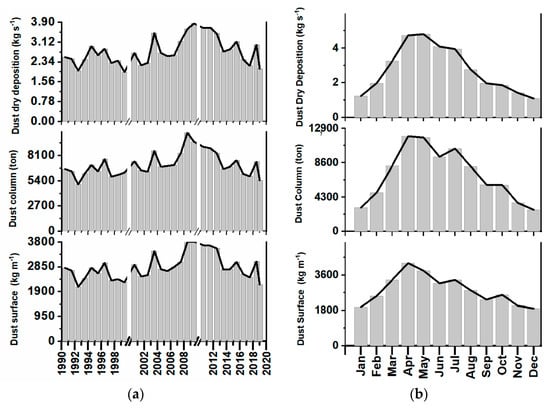
Figure 9.
Average in the basin area: (a) inter-annual and (b) monthly variation of dust surface (), dust column density (), and dry deposition (), 1990–2019.
The seasonal trend Illustrates the highest value of dust surface concentration, dust column density, and dust dry deposition occurring similarly in April, July, and October in the Urmia Basin (Figure 10), with only minor differences in May and September. Observational data in Mahabad, Urmia, and Sarab stations show the highest dust in May and October, while MERRA-2 data shows April, May, and October. There is a minor difference between the two data sets in April.
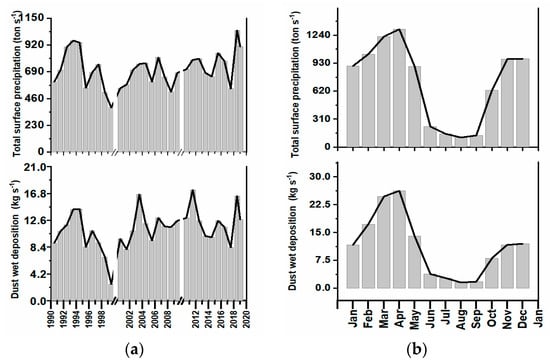
Figure 10.
Average in the basin area: (a) inter-annual and (b) monthly variation of dust wet deposition () and total surface precipitation (), 1990–2019.
It is understood that the Urmia Basin receives the most significant impact of dust storm events in May, according to both observational and MERRA-2 data. The rise of dust column density and dust dry deposition represents the influence of migratory weather systems and their effect on dust events in April and October, which agrees with previous studies. The highest dry deposition was obtained in two transitional seasons, spring and summer, in Iran [44] and in the eastern Mediterranean [20].
The annual distribution of wet deposition and precipitation fluctuates similarly, demonstrating a close relationship between these two variables. The wet deposition has a positive correlation of 0.79 with precipitation, 0.59 with dust dry deposition, and 0.52 with dust surface concentration. This indicates that precipitation has a significant effect on dust wet deposition in both temporal (Figure 10) and spatial distribution (Figure 5b,c).
There was a significant increase in dust wet sedimentation in 2003 and 2012, but the precipitation did not drive this enhancement, suggesting that dust’s dominant effect on wet sedimentation during those years was more significant.
The monthly distribution of dust, wet deposition, and precipitation display similar patterns. There is an increase in precipitation from January to April, followed by a downward trend until October.
The number of dusty days experiences a rapid increase from April to May (Figure 8a). At the same time, precipitation and dust wet deposition show a sharp decline from April to May (Figure 9 and Figure 10). This demonstrates the impact of reduced precipitation on surface drying and the creation of favorable conditions for dust emission from source areas within a month during spring.
From another perspective, there is an increase in precipitation, dust wet deposition, dust dry deposition, dust column density in MERRA-2 data, and the number of dusty days in October (Figure 8 and Figure 9). The conditions for dust occurrence in October differ from those in May due to increased precipitation, with precipitation rising from September to October, signaling the arrival of autumn in the region. The lands that serve as dust sources are dry because of the passing summertime and no rain, so dust is emitted from the surface when synoptic systems are activated. This is why an increase in dust and dust wet deposition is associated with rising precipitation in October.
During rainy periods, including spring and autumn, a significant increase in the frequency of dusty days has been achieved in Tabriz [75]. These research results align with those of [44], who found that the highest dry deposition occurred in spring and summer in Iran.
The averages of the variables in the Urmia Basin are displayed in Table 6. The annual average of variables is multiplied by the basin area, which results in a change in their units due to large values.

Table 6.
Decade average dust surface concentration (), dust column density in , dust dry deposition in , dust wet deposition in , total surface precipitation in , dust extinction AOT (AOTA), and total aerosol extinction AOT (AOTD).
The highest values of dust surface concentration, dust column density, dust dry deposition, and AOT dust were obtained at 3043, 7866, 2.91, and 0.098 in the 2000s, which correlates with the increasing number of dusty days in this decade (Figure 7). The AOT aerosol had the highest value of 0.186 in the 1990s, demonstrating the difference in the behavior of AOT dust and aerosol. The average AOT aerosol decreased from the 1990s to the 2010s, while AOT dust increased from the 1990s to the 2000s.
Ghale et al. (2021) [28] utilized AOD data obtained from the MODIS sensor and found values of 0.25 and 0.42 for the 2000s and 2010s, respectively, which indicates an increase in air pollution caused by aerosols in the 2010s. The difference in results could be due to the use of different types and horizontal resolutions in the AOD database, as well as different selected areas for calculating the average. The maximum dust wet deposition and precipitation values of 12.4 and 776 , respectively, were obtained in the 2010s, indicating a correlation between precipitation and dust wet deposition. The increase in precipitation in the 2010s led to an increase in soil moisture, which, in turn, reduced erosion potential, and this process was particularly evident in 2019.
The correlation coefficient was calculated between the number of dusty days and the dust variables from MERRA-2 data within the annual period in the selected stations (Table 7). In all four stations, the number of dusty days has the highest correlation coefficient (greater than 0.5) with respect to dust surface and dust dry deposition.

Table 7.
Annual correlation between number of dusty days (observation) with MEERA-2 dust variables, total surface precipitation, dust extinction AOT (AOTA), and total aerosol extinction AOT (AOTD) (1990–2019).
Since dust surface concentration and dust dry deposition represent dust near the surface, they correlate well with the data recorded in meteorological stations. However, other variables, such as dust column density and dust wet deposition, do not have a significant correlation with observational data. The reason is that these deposits are more influenced by precipitation. Dust column density also shows the amount of dust from the surface to the upper layers of the atmosphere. Since the data reports at meteorological stations pertain to conditions near the surface, they do not have information about dust conditions in the upper layers of the atmosphere.
In Tabriz, dust surface, dust dry deposition, dust column, and AOT of dust (AOTD) have a positive correlation coefficient of 0.74, 0.71, 0.69, and 0.68, respectively. Considering Tabriz’s location in relation to Lake Urmia, its mountainous structure, and wind direction (Figure 4c,d), it can be concluded that there is local dust in the northeast of the lake, which leads to an increase in dust suspended in the air and transported by wind toward Tabriz.
The dusty day number has the highest correlation with dust surface concentration, dust dry deposition, dust column density, and AOT aerosol, respectively. The dusty day number has the greatest compatibility with dust surface concentration. The correlation between dusty day numbers and MERRA-2 dust data is higher in Tabriz and Urmia than in the other locations. The highest correlation (0.74) was obtained between the dusty day number and dust surface concentration in Tabriz, followed by dust dry deposition, dust column, and AOD aerosol, with 0.71, 0.69, and 0.68, respectively. The best correlation obtained in Tabriz is likely due to it having the longest period of dust data from 1990 to 2019.
The worst correlation between observation and MERRA-2 data is achieved for dust wet deposition and precipitation, mainly because the major dust season is spring, particularly May, when the weather becomes warmer and precipitation decreases. The dust column density and AOD aerosol data indicate that the amount of lifted dust and aerosol in the air column is lowest in Mahabad and Sarab. The higher elevation and complex topography are reasons why dust cannot easily extend into the air column. The mountains act as barriers, trapping dust on their slopes.
Case study dust event: 28–31 October 2017.
This widespread, persistent, and intense dust event took place in northwestern Iran and the Urmia Basin on 28–31 October 2017 (see more details in [69]).
Here, the short explanation presents how the synoptic system emitted dust and transported it to the Urmia Basin.
The synoptic analysis on 28 October indicates the mid-tropospheric trough and the surface low over Iraq, while southwesterly winds contributed to the transport of dust from Iraq toward the Urmia Basin. This is the reason for an increase in dust concentration over the Urmia Basin, while at 0600 UTC on 29 October, horizontal visibility was reduced to 3000 m, and PM10 concentration increased to 550 µg m−3. This condition continued until 1800 UTC on 29 October, with the highest concentrations of 935 µg m−3 and 410 µg m−3 of PM10 in Tabriz and Urmia, respectively.
The development of a surface low pressure and dust emission continued until 30 October over Iraq; so, relatively strong wind speeds at 850 hPa transported dust toward Urmia Basin and deposited persistent dust in this area. The high PM10 concentrations at 1800 and 2100 UTC on 30 October in Tabriz and Urmia were associated with a reduction in horizontal visibility.
The severe dust mass is displayed in the MODIS image on 29 October (Figure 11a). The backward particle trajectory received in Urmia and Tabriz at 1800 UTC 29 October shows transported dust from northeastern and central Iraq (Figure 11a). The particles passed over the dried part of the Urmia Basin toward Tabriz; hence, it is a reason why the PM10 concentration was the highest in Tabriz. The particles transported from eastern Iraq toward Sarab were located in east of the Urmia Basin and towards Mahabad were located in the southwest. The main source of Urmia Basin dust is Iraq, and the dried lake bed contributed to the increasing dust concentration in Tabriz.
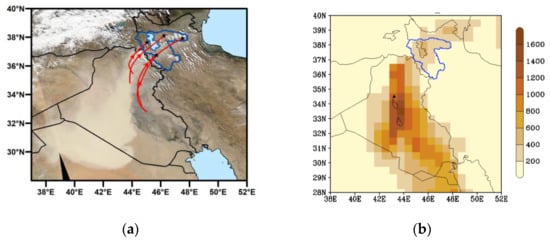
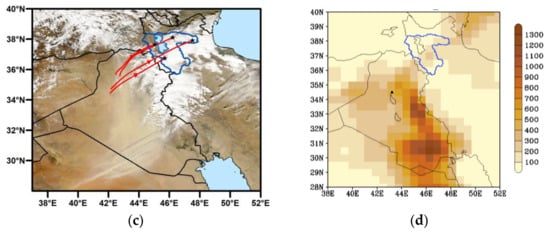
Figure 11.
(a) MODIS visible imagery on 29 October 2017 and HYSPLIT model backward trajectory (show in red arrows) ending at 1800 UTC 29 October 2017; (b) MERRA-2 surface dust concentration (μg m−3) at 0600 UTC on 29 October 2017; (c) same as (a) on 30 October 2017 and HYSPLIT model backward trajectory (show in red arrows) ending at 1800 UTC 30 October 2017; (d) same as (b) at 0600 UTC on 30 October 2017. The local time is UTC + 3:30 h. Filled triangle shows selected synoptic station, the Urmia Basin border shows in line blue.
The maximum surface dust concentration at 0600 UTC 29 October was emitted over Iraq from north to south (Figure 11b). The spatial distribution of the dust is similar to the MODIS image (Figure 11a), while there are some differences in detail over Saudi Arabia. The increasing dust concentration in the eastern Urmia Lake is illustrated in the MERRA-2 data (Figure 11b).
The dust mass took placed from north to south Iraq, which is more concentrated in the south area (Figure 11c) on 30 October. The cloud covered eastern Iraq to western and northwest Iran. The cloud hides the under-dust mass. The northeastern ward of the HYSPLIT pathway carried dust particles from Iraq north toward the Urmia Basin to four Urmia Basin stations. The particles passed over Urmia Lake toward Tabriz on the 29th of October. The MERRA-2 surface dust concentration (Figure 11d) and MODIS image (Figure 11d), though disturbed, are similar on the 30th of October, so the highest surface dust concentration and dust mass in southern Iraq can be seen in both.
5. Conclusions
The spatial distribution of dust surface concentration (MERRA-2 data) and the number of dusty days (observational data) both show a coincidental decrease from the southwest to the northwest of the Urmia Basin, attributable to the increasing distance from the main dust sources in Iraq and Syria. The southwest wind direction at 700 hPa supports the transport of dust from Iraq to the Urmia Basin. Moreover, the prevailing wind rose direction at meteorological stations is consistent with the 700 hPa wind direction.
The complex topographical structure, its impact on wind speed and direction, and the various mechanisms affecting dust emission and transport, local geographical conditions, and distance from Lake Urmia all contribute to the decreasing dust from west to east in the Urmia Basin. Furthermore, the wind rose indicates westerly winds during dust events. The passage of synoptic systems and local factors, including topography, vegetation, and soil, can influence the direction and speed of near-surface winds.
Lake Urmia, situated in the center of the basin and surrounded by mountains, causes the wind direction at 850 hPa to shift to southerly, potentially leading to erosion of the dried lakebed. The distribution of dust column density and dust dry deposition is affected by the surrounding mountainous structure and drying area, resulting in the highest dust column density values south of Lake Urmia due to dust lifting into the upper atmosphere.
Temporal analysis reveals an increase in the number of dusty days from 1990 to 2019 in the Urmia Basin. MERRA-2 dust data and visibility indicate the highest dust values and intensities during the 2000s. Seasonal distribution results demonstrate the maximum number of dusty days and MERRA-2 dust variables occurring in May and April (spring), as well as in October (autumn).
Observational data (number of dusty days) show a positive correlation with MERRA-2 dust data, including dust surface concentration and dust dry deposition. The number of dusty days is positively correlated with dust surface concentration, dust dry deposition, column mass dust, and total aerosol extinction, with coefficients of 0.74, 0.71, 0.69, and 0.68, respectively.
The highest number of dusty events, totaling 728 days, was recorded in Tabriz, northeast of Lake Urmia, from 1990 to 2019, amounting to nearly 2.5 times that of Urmia city. The dried lakebed and alluvial plains of the northeastern basin may serve as the primary local dust sources for Tabriz, explaining the higher frequency and intensity of dust events in this city within the Urmia Basin. The backward HYSPLIT model pathway was confirmed to pass the dust particles over the dried-bed Urmia Lake toward Tabriz. A significant difference was observed between observational and MERRA-2 data in Tabriz. Although MERRA-2 dust data show a suitable agreement with observational data in spatial and temporal distribution, the highest number of dusty days in Tabriz could not be detected via MERRA-2 dust data due to the occurrence of some phenomena at smaller scales than the coarse MERRA-2 grid points.
The MODIS image and the surface dust concentration from MERRA-2 data consist of dust events on the 29th and 30th of October 2017.
In conclusion, this study demonstrates the complex interplay of factors that influence dust events in the Urmia Basin, including topography, wind patterns, and proximity to dust sources. The MERRA-2 data generally align well with observational data in terms of spatial and temporal distribution, although there are some discrepancies, particularly in Tabriz. This research provides valuable insights into the characteristics of dust events in the region, which can help inform future studies and inform policy decisions intended to mitigate the impact of dust on human health, agriculture, and the environment.
Author Contributions
E.M.H.: Conceptualization, Methodology, Data Curation, Formal analysis, Visualization, Writing—Original Draft, Software; E.F.: Supervision, Methodology, Writing—Review & Editing; M.H.: Conceptualization, Validation, Writing final Draft—Review & Editing, Visualization. All authors have read and agreed to the published version of the manuscript.
Funding
This work is funded by Open Access Funding by the University of Graz.
Informed Consent Statement
Not applicable.
Data Availability Statement
All data used in this study are available upon request. The data that support the findings of this study are openly available in the following links: MERRA-2 data: https://giovanni.gsfc.nasa.gov/giovanni/#service=TmAvMp&starttime=&endtime=&variableFacets=dataProductPlatformInstrument%3AMERRA-2%20Reanalysis%3B. Observation data: https://www.irimo.ir/eng/index.php. MODIS image: https://worldview.earthdata.nasa.gov/. HYSPLIT model: https://www.ready.noaa.gov/hypub-bin/trajtype.pl.
Acknowledgments
We express our gratitude to NASA GES DISC for providing the MERRA-2 dataset and to Iran Meteorological Organization for their observational date. The authors also acknowledge Open Access Funding by the University of Graz. Thank you to all who have contributed to this research.
Conflicts of Interest
The authors declare no conflict of interest.
References
- Prospero, J.M.; Ginoux, P.; Torres, O.; Nicholson, S.E.; Gill, T.E. Environmental characterization of global sources of atmospheric soil dust identified with the Nimbus 7 Total Ozone Mapping Spectrometer (TOMS) absorbing aerosol product. Rev. Geophys. 2002, 40, 2-1–2-31. [Google Scholar] [CrossRef]
- Goudie, A.S.; Middleton, N.J. Desert Dust in the Global System; Springer Science & Business Media: Berlin/Heidelberg, Germany, 2006. [Google Scholar]
- Ginoux, P.; Prospero, J.M.; Gill, T.E.; Hsu, N.C.; Zhao, M. Global-scale attribution of anthropogenic and natural dust sources and their emission rates based on MODIS Deep Blue aerosol products. Rev. Geophys. 2012, 50, RG3005. [Google Scholar] [CrossRef]
- D’Odorico, P.; Bhattachan, A.; Davis, K.F.; Ravi, S.; Runyan, C.W. Global desertification: Drivers and feedbacks. Adv. Water Resour. 2013, 51, 326–344. [Google Scholar] [CrossRef]
- Mahowald, N.M.; Muhs, D.R.; Levis, S.; Rasch, P.J.; Yoshioka, M.; Zender, C.S.; Luo, C. Change in atmospheric mineral aerosols in response to climate: Last glacial period, preindustrial, modern, and doubled carbon dioxide climates. J. Geophys. Res. Atmos. 2006, 111. [Google Scholar] [CrossRef]
- Goudie, A.S. Dust storms: Recent developments. J. Environ. Manag. 2009, 90, 89–94. [Google Scholar] [CrossRef] [PubMed]
- Powell, J.T.; Chatziefthimiou, A.D.; Banack, S.A.; Cox, P.A.; Metcalf, J.S. Desert crust microorganisms, their environment, and human health. J. Arid. Environ. 2015, 112, 127–133. [Google Scholar] [CrossRef]
- Yang, Y.; Russell, L.M.; Lou, S.; Liao, H.; Guo, J.; Liu, Y.; Singh, B.; Ghan, S.J. Dust-wind interactions can intensify aerosol pollution over eastern China. Nat. Commun. 2017, 8, 15333. [Google Scholar] [CrossRef]
- Washington, R.; Todd, M.C.; Engelstaedter, S.; Mbainayel, S.; Mitchell, F. Dust and the low-level circulation over the Bodélé Depression, Chad: Observations from BoDEx 2005. J. Geophys. Res. Atmos. 2006, 111. [Google Scholar] [CrossRef]
- Kaskaoutis, D.; Rashki, A.; Francois, P.; Dumka, U.; Houssos, E.; Legrand, M. Meteorological regimes modulating dust outbreaks in southwest Asia: The role of pressure anomaly and Inter-Tropical Convergence Zone on the 1–3 July 2014 case. Aeolian Res. 2015, 18, 83–97. [Google Scholar] [CrossRef]
- Kaskaoutis, D.G.; Houssos, E.; Rashki, A.; Francois, P.; Legrand, M.; Goto, D.; Bartzokas, A.; Kambezidis, H.; Takemura, T. The Caspian Sea–Hindu Kush Index (CasHKI): A regulatory factor for dust activity over southwest Asia. Glob. Planet. Change 2016, 137, 10–23. [Google Scholar] [CrossRef]
- Zhang, X.Y.; Arimoto, R.; An, Z.S. Dust emission from Chinese desert sources linked to variations in atmospheric circulation. J. Geophys. Res. Atmos. 1997, 102, 28041–28047. [Google Scholar] [CrossRef]
- Zhang, X.; Shi, P.; Liu, L.; Tang, Y.; Cao, H.; Zhang, X.; Hu, X.; Guo, L.; Lue, Y.; Qu, Z. Ambient TSP concentration and dustfall in major cities of China: Spatial distribution and temporal variability. Atmos. Environ. 2010, 44, 1641–1648. [Google Scholar] [CrossRef]
- Buseck, P.R.; Jacob, D.J.; Pósfai, M.; Li, J.; Anderson, J. Minerals in the air: An environmental perspective. Int. Geol. Rev. 2000, 42, 577–593. [Google Scholar] [CrossRef]
- Awad, A.; Mashat, A.-W. The synoptic patterns associated with spring widespread dusty days in central and eastern Saudi Arabia. Atmosphere 2014, 5, 889–913. [Google Scholar] [CrossRef]
- Bou Karam Francis, D.; Flamant, C.; Chaboureau, J.-P.; Banks, J.; Cuesta, J.; Brindley, H.; Oolman, L. Dust emission and transport over Iraq associated with the summer Shamal winds. Aeolian Res. 2017, 24, 15–31. [Google Scholar] [CrossRef]
- Jin, Q.; Wei, J.; Pu, B.; Yang, Z.L.; Parajuli, S.P. High summertime aerosol loadings over the Arabian Sea and their transport pathways. J. Geophys. Res. Atmos. 2018, 123, 10568–10590. [Google Scholar] [CrossRef]
- Li, F.-R.; Zhao, L.-Y.; Zhang, H.; Zhang, T.-H.; Shirato, Y. Wind erosion and airborne dust deposition in farmland during spring in the Horqin Sandy Land of eastern Inner Mongolia, China. Soil Tillage Res. 2004, 75, 121–130. [Google Scholar] [CrossRef]
- Goudie, A.S. Desert dust and human health disorders. Environ. Int. 2014, 63, 101–113. [Google Scholar] [CrossRef]
- Kubilay, N.; Nickovic, S.; Moulin, C.; Dulac, F. An illustration of the transport and deposition of mineral dust onto the eastern Mediterranean. Atmos. Environ. 2000, 34, 1293–1303. [Google Scholar] [CrossRef]
- Vincent, J.; Laurent, B.; Losno, R.; Bon Nguyen, E.; Roullet, P.; Sauvage, S.; Chevaillier, S.; Coddeville, P.; Ouboulmane, N.; di Sarra, A.G. Variability of mineral dust deposition in the western Mediterranean basin and south-east of France. Atmos. Chem. Phys. 2016, 16, 8749–8766. [Google Scholar] [CrossRef]
- Rashki, A.; Middleton, N.J.; Goudie, A.S. Dust storms in Iran–Distribution, causes, frequencies and impacts. Aeolian Res. 2021, 48, 100655. [Google Scholar] [CrossRef]
- Mohammadpour, K.; Sciortino, M.; Kaskaoutis, D.G. Classification of weather clusters over the Middle East associated with high atmospheric dust-AODs in West Iran. Atmos. Res. 2021, 259, 105682. [Google Scholar] [CrossRef]
- Shahkooeei, E.; Rahmani, T. Dust Risk Assessment in Northwest of Iran. Spat. Plan. 2019, 9, 57–80. [Google Scholar] [CrossRef]
- Mardi, A.H.; Khaghani, A.; MacDonald, A.B.; Nguyen, P.; Karimi, N.; Heidary, P.; Karimi, N.; Saemian, P.; Sehatkashani, S.; Tajrishy, M. The Lake Urmia environmental disaster in Iran: A look at aerosol pollution. Sci. Total Environ. 2018, 633, 42–49. [Google Scholar] [CrossRef] [PubMed]
- Ghomashi, F.; Khalesifard, H.R. Investigation and characterization of atmospheric aerosols over the Urmia Lake using the satellite data and synoptic recordings. Atmos. Pollut. Res. 2020, 11, 2076–2086. [Google Scholar] [CrossRef]
- Isazade, V.; Qasimi, A.B.; Kaplan, G. Investigation of the Effects of Salt Dust Caused by Drying of Urmia Lake on the Sustainability of Urban Environments. J. Clean WAS 2021, 5, 78–84. [Google Scholar] [CrossRef]
- Ghale, Y.A.G.; Tayanc, M.; Unal, A. Dried bottom of Urmia Lake as a new source of dust in the northwestern Iran: Understanding the impacts on local and regional air quality. Atmos. Environ. 2021, 262, 118635. [Google Scholar] [CrossRef]
- Rahimi-Garachepeg, Z.; Zarandi-Miandoab, L.; Chaparzadeh, N. Effect of salt dust caused by drying of Lake Urmia on three strategic crops of Azerbaijan. J. Nat. Environ. Hazards 2022, 11, 65–84. [Google Scholar]
- Sotoudeheian, S.; Salim, R.; Arhami, M. Impact of Middle Eastern dust sources on PM10 in Iran: Highlighting the impact of Tigris-Euphrates basin sources and Lake Urmia desiccation. J. Geophys. Res. Atmos. 2016, 121, 14018–14034. [Google Scholar] [CrossRef]
- Delju, A.H.; Ceylan, A.; Piguet, E.; Rebetez, M. Observed climate variability and change in Urmia Lake Basin, Iran. Theor. Appl. Climatol. 2013, 111, 285–296. [Google Scholar] [CrossRef]
- Nikbakht, J.; Tabari, H.; Talaee, P.H. Streamflow drought severity analysis by percent of normal index (PNI) in northwest Iran. Theor. Appl. Climatol. 2013, 112, 565–573. [Google Scholar] [CrossRef]
- Gholampour, A.; Nabizadeh, R.; Hassanvand, M.S.; Nazmara, S.; Mahvi, A.H. Elemental composition of particulate matters around Urmia Lake, Iran. Toxicol. Environ. Chem. 2017, 99, 17–31. [Google Scholar] [CrossRef]
- Arkian, F.; Nicholson, S.E.; Ziaie, B. Meteorological factors affecting the sudden decline in Lake Urmia’s water level. Theor. Appl. Climatol. 2018, 131, 641–651. [Google Scholar] [CrossRef]
- Yao, W.; Che, H.; Gui, K.; Wang, Y.; Zhang, X. Can MERRA-2 reanalysis data reproduce the three-dimensional evolution characteristics of a typical dust process in East Asia? A case study of the dust event in May 2017. Remote Sens. 2020, 12, 902. [Google Scholar] [CrossRef]
- Carmona, J.M.; Gupta, P.; Lozano-García, D.F.; Vanoye, A.Y.; Yépez, F.D.; Mendoza, A. Spatial and temporal distribution of PM2.5 pollution over northeastern Mexico: Application of MERRA-2 reanalysis datasets. Remote Sens. 2020, 12, 2286. [Google Scholar] [CrossRef]
- Ukhov, A.; Mostamandi, S.; Da Silva, A.; Flemming, J.; Alshehri, Y.; Shevchenko, I.; Stenchikov, G. Assessment of natural and anthropogenic aerosol air pollution in the Middle East using MERRA-2, CAMS data assimilation products, and high-resolution WRF-Chem model simulations. Atmos. Chem. Phys. 2020, 20, 9281–9310. [Google Scholar] [CrossRef]
- Tuygun, G.T.; Gündoğdu, S.; Elbir, T. Estimation of ground-level particulate matter concentrations based on synergistic use of MODIS, MERRA-2 and AERONET AODs over a coastal site in the Eastern Mediterranean. Atmos. Environ. 2021, 261, 118562. [Google Scholar] [CrossRef]
- Liu, C.; Yin, Z.; He, Y.; Wang, L. Climatology of Dust Aerosols over the Jianghan Plain Revealed with Space-Borne Instruments and MERRA-2 Reanalysis Data during 2006–2021. Remote Sens. 2022, 14, 4414. [Google Scholar] [CrossRef]
- Ou, Y.; Li, Z.; Chen, C.; Zhang, Y.; Li, K.; Shi, Z.; Dong, J.; Xu, H.; Peng, Z.; Xie, Y. Evaluation of MERRA-2 Aerosol Optical and Component Properties over China Using SONET and PARASOL/GRASP Data. Remote Sens. 2022, 14, 821. [Google Scholar] [CrossRef]
- Shikwambana, L.; Kganyago, M. Meteorological Influence of Mineral Dust Distribution Over South-Western Africa Deserts Using Reanalysis and Satellite Data. Front. Environ. Sci. 2022, 10, 856438. [Google Scholar] [CrossRef]
- Nazish Khan, M.; Sajid Akhter, M. Spatial variability and trend analysis of dust aerosols loading over Indian sub-continent using MERRA 2 & CALIPSO data. Geol. Ecol. Landsc. 2022, 2022, 1–9. [Google Scholar]
- Dehestani Ardakani, M.R. Dust time series analysis using long-term monthly images of MERRA2 satellites and Sentinel5 images in Google Earth Engine. J. Nat. Spat. Sci. 2021, 1, 16–26. [Google Scholar]
- Dadashi-Roudbari, A.; Ahmadi, M.; Shakiba, A. Seasonal Study of dust deposition and fine particles (PM 2.5) in Iran Using MERRA-2 data. Iran. J. Geophys. 2020, 13, 43–59. [Google Scholar]
- Mobarak hassan, E.; Saadatabadi, A.; Fattahi, E. Dust Investigation by MERRA-2 Model in Iran: (during 2007–2017). Iran. J. Soil Water Res. 2020, 51, 2203–2219. [Google Scholar]
- Mobarak Hassan, E.; Noori, F.; Abdoli, M. Investigating the distribution of chlorophyll in Lake Urmia using remote sensing (2003–2020). In Proceedings of the 5th International Conference on the Persian Gulf Oceanpgraphy, Tehran, Iran, 25 January 2022. [Google Scholar]
- Zarghami, M. Effective watershed management; case study of Urmia Lake, Iran. Lake Reserv. Manag. 2011, 27, 87–94. [Google Scholar] [CrossRef]
- Boroughani, M.; Hashemi, H.; Hosseini, S.H.; Pourhashemi, S.; Berndtsson, R. Desiccating Lake Urmia: A new dust source of regional importance. IEEE Geosci. Remote Sens. Lett. 2019, 17, 1483–1487. [Google Scholar] [CrossRef]
- Saeidabadi, R. Investigation of impact of land-cover change on climate factors on surrounding areas of Urmia Lake. J. Arid. Reg. Geogr. Stud. 2016, 6, 34–49. [Google Scholar]
- Hamzehpour, N.; Eghbal, M.; Bogaert, P.; Toomanian, N. Top soil salinity prediction in South-Western part of Urmia Lake with ground water data. Int. J. Agric. Res. Innov. Technol. 2014, 4, 57–63. [Google Scholar] [CrossRef]
- Emdadi, A.; Gikas, P.; Farazaki, M.; Emami, Y. Salinity gradient energy potential at the hyper saline Urmia Lake–ZarrinehRud River system in Iran. Renew. Energy 2016, 86, 154–162. [Google Scholar] [CrossRef]
- Habibi, M.; Babaeian, I.; Schöner, W. Changing Causes of Drought in the Urmia Lake Basin—Increasing Influence of Evaporation and Disappearing Snow Cover. Water 2021, 13, 3273. [Google Scholar] [CrossRef]
- Rasouli, A.A.; Abbasian, S.; Jahanbakhash, S. Monitoring of Armia lake water surface fluxtuations of mult-sensors and multi-temporal imageries. Modares Hum. Sci. 2008, 12, 54–71. [Google Scholar]
- Feizizadeh, B.; Garajeh, M.K.; Lakes, T.; Blaschke, T. A deep learning convolutional neural network algorithm for detecting saline flow sources and mapping the environmental impacts of the Urmia Lake drought in Iran. Catena 2021, 207, 105585. [Google Scholar] [CrossRef]
- Garajeh, M.K.; Malakyar, F.; Weng, Q.; Feizizadeh, B.; Blaschke, T.; Lakes, T. An automated deep learning convolutional neural network algorithm applied for soil salinity distribution mapping in Lake Urmia, Iran. Sci. Total Environ. 2021, 778, 146253. [Google Scholar] [CrossRef] [PubMed]
- Dehghanipour, A.H.; Moshir Panahi, D.; Mousavi, H.; Kalantari, Z.; Tajrishy, M. Effects of Water Level Decline in Lake Urmia, Iran, on Local Climate Conditions. Water 2020, 12, 2153. [Google Scholar] [CrossRef]
- Garousi, V.; Najafi, A.; Samadi, A.; Rasouli, K.; Khanaliloo, B. Environmental crisis in Lake Urmia, Iran: A systematic review of causes, negative consequences and possible solutions. In Proceedings of the 6th International Perspective on Water Resources & the Environment (IPWE), Izmir, Turkey, 7–9 January 2013. [Google Scholar]
- Asghari-Kaljahi, E.; Hoseinpour, S.; Nadiri, A.O. Evaluation of salt dust occurrence potential in the North east Zone of Urmia Lake. Environ. Eros. Res. J. 2018, 8, 42–61. [Google Scholar]
- Nadersefat, M.H. The geomorphologic characteristics on the Armia lake and that effect in this region ecosystem. Daneshnameh 2011, 82, 23–32. [Google Scholar]
- Ahmady-Birgani, H.; Ravan, P.; Schlosser, J.S.; Cuevas-Robles, A.; AzadiAghdam, M.; Sorooshian, A. On the chemical nature of wet deposition over a major desiccated lake: Case study for Lake Urmia basin. Atmos. Res. 2020, 234, 104762. [Google Scholar] [CrossRef]
- Cuevas Agulló, E. Establishing a WMO Sand and Dust Storm Warning Advisory and Assessment System Regional Node for West Asia: Current Capabilities and Needs: Technical Report; World Meteorological Organization: Geneva, Switzerland, 2013. [Google Scholar]
- Zhang, X.X.; Sharratt, B.; Chen, X.; Wang, Z.F.; Liu, L.Y.; Guo, Y.H.; Li, J.; Chen, H.S.; Yang, W.Y. Dust deposition and ambient PM10 concentration in northwest China: Spatial and temporal variability. Atmos. Chem. Phys. 2017, 17, 1699–1711. [Google Scholar] [CrossRef]
- Fiedler, S.; Schepanski, K.; Heinold, B.; Knippertz, P.; Tegen, I. Climatology of nocturnal low-level jets over North Africa and implications for modeling mineral dust emission. J. Geophys. Res. Atmos. 2013, 118, 6100–6121. [Google Scholar] [CrossRef]
- Schepanski, K.; Tegen, I.; Todd, M.C.; Heinold, B.; Bönisch, G.; Laurent, B.; Macke, A. Meteorological processes forcing Saharan dust emission inferred from MSG-SEVIRI observations of subdaily dust source activation and numerical models. J. Geophys. Res. Atmos. 2009, 114. [Google Scholar] [CrossRef]
- Milton, S.; Greed, G.; Brooks, M.; Haywood, J.; Johnson, B.; Allan, R.; Slingo, A.; Grey, W. Modeled and observed atmospheric radiation balance during the West African dry season: Role of mineral dust, biomass burning aerosol, and surface albedo. J. Geophys. Res. Atmos. 2008, 113, D00C02. [Google Scholar] [CrossRef]
- Washington, R.; Todd, M.C. Atmospheric controls on mineral dust emission from the Bodélé Depression, Chad: The role of the low level jet. Geophys. Res. Lett. 2005, 32, L17701. [Google Scholar] [CrossRef]
- Marticorena, B.; Bergametti, G.; Aumont, B.; Callot, Y.; N’Doumé, C.; Legrand, M. Modeling the atmospheric dust cycle: 2. Simulation of Saharan dust sources. J. Geophys. Res. Atmos. 1997, 102, 4387–4404. [Google Scholar] [CrossRef]
- Molod, A.; Takacs, L.; Suarez, M.; Bacmeister, J. Development of the GEOS-5 atmospheric general circulation model: Evolution from MERRA to MERRA2. Geosci. Model Dev. 2015, 8, 1339–1356. [Google Scholar] [CrossRef]
- Mobarak Hassan, E.; Karimkhani, M.; Alizadeh, O. Synoptic analysis and simulation of a widespread dust event in the Urmia Basin. Nat. Hazards 2023, 2023, 1–26. [Google Scholar] [CrossRef]
- Draxler, R.; Stunder, B.; Rolph, G.; Stein, A.; Taylor, A. HYSPLIT4 User’s Guide, Air Resources Laboratory, National Oceanic and Atmospheric Administration (NOAA); NOAA: Silver Spring, MD, USA, 2020.
- Guieu, C.; Loÿe-Pilot, M.D.; Ridame, C.; Thomas, C. Chemical characterization of the Saharan dust end-member: Some biogeochemical implications for the western Mediterranean Sea. J. Geophys. Res. Atmos. 2002, 107, ACH 5-1–ACH 5-11. [Google Scholar] [CrossRef]
- Mahowald, N.M.; Baker, A.R.; Bergametti, G.; Brooks, N.; Duce, R.A.; Jickells, T.D.; Kubilay, N.; Prospero, J.M.; Tegen, I. Atmospheric global dust cycle and iron inputs to the ocean. Glob. Biogeochem. Cycles 2005, 19, GB4025. [Google Scholar] [CrossRef]
- Santos, A.M.J. Influence of Saharan Aerosols on Phytoplankton Biomass in the Tropical North Atlantic Ocean; University of Puerto Rico, Mayagüez Campus: Mayagüez, Puerto Rico, 2010. [Google Scholar]
- Fatahi, E.; Araghizadeh, M.; MobarakHassan, E.; Khansalari, S.; Hossein Hamzeh, N. Study of the mechanism and source of dust in Khorasan Razavi province by RegCM4 and HYSPLIT model: A case study (July 1, 2014). J. Clim. Res. 2022, 13, 27–44. [Google Scholar]
- Hoseine Sadr, A.; Mohammadi, G.H.; Hoseine Sadr, M. Trend analysis of dust Tabriz. Nivar 2014, 38, 3–10. [Google Scholar]
- Khosh Akhlagh, F.; Pazhoh, F.; Jafari, F.; Kohi, S. Synoptic analysis of Iran’s northwest dust storms. J. Meteorol. Atmos. Sci. 2020, 2, 272–286. [Google Scholar]
Disclaimer/Publisher’s Note: The statements, opinions and data contained in all publications are solely those of the individual author(s) and contributor(s) and not of MDPI and/or the editor(s). MDPI and/or the editor(s) disclaim responsibility for any injury to people or property resulting from any ideas, methods, instructions or products referred to in the content. |
© 2023 by the authors. Licensee MDPI, Basel, Switzerland. This article is an open access article distributed under the terms and conditions of the Creative Commons Attribution (CC BY) license (https://creativecommons.org/licenses/by/4.0/).